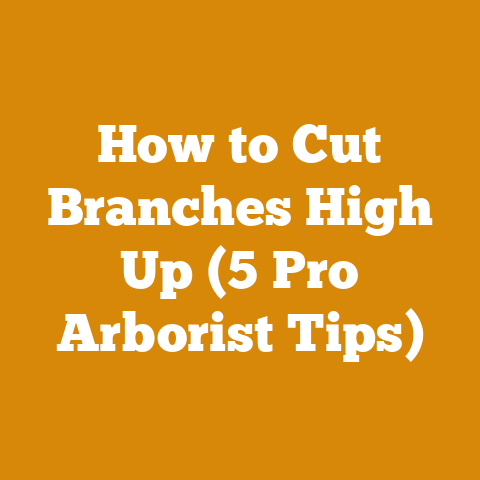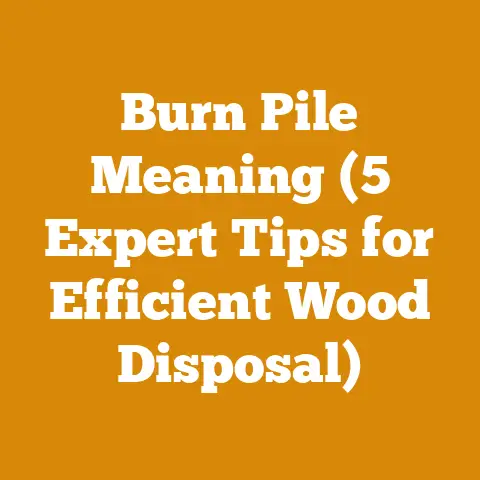Deep Root Fertilizer for Trees (5 Pro Arborist Tips)
Have you ever looked at a majestic tree and wondered what it takes to keep it thriving?
Or perhaps you’ve noticed your own trees aren’t looking quite as vibrant as they used to.
I understand.
I’ve spent years in the woods, from felling timber to preparing firewood, and I’ve learned that even the mightiest giants need a little help sometimes.
Just like a good splitting axe needs regular maintenance, trees require proper nourishment.
Deep root fertilization is a pro-level technique that can make all the difference.
But like any good tool, understanding its use and the associated costs is key.
In this article, I’ll break down everything you need to know about deep root fertilization, sharing pro tips, cost considerations, and insights I’ve gained from my time in the field.
Let’s dig in and give your trees the boost they deserve!
Deep Root Fertilizer for Trees: 5 Pro Arborist Tips and Cost Breakdown
Deep root fertilization is a game-changer for tree health.
It’s like giving your trees a targeted vitamin boost right where they need it most – the roots.
This method delivers essential nutrients directly into the soil, promoting healthy growth, vibrant foliage, and increased resistance to pests and diseases.
As someone who’s spent countless hours in the woods, I can tell you firsthand that healthy trees are the foundation of a healthy ecosystem.
But, like any specialized service, understanding the costs involved is crucial before you start.
1. Understanding Deep Root Fertilization: What It Is and Why It Matters
Deep root fertilization involves injecting a liquid fertilizer solution directly into the soil around the tree’s root zone.
This bypasses the surface layer of soil, which can often be compacted or nutrient-depleted, ensuring that the roots receive the nutrients they need.
Why is this important?
- Targeted Nutrient Delivery: Unlike surface fertilization, which can be washed away or taken up by competing plants, deep root fertilization delivers nutrients directly to the roots.
- Improved Soil Health: The process can also improve soil aeration and drainage, creating a more favorable environment for root growth.
- Enhanced Tree Health: A well-nourished tree is better equipped to resist pests, diseases, and environmental stresses like drought.
- Increased Growth and Vigor: Deep root fertilization can promote new growth, denser foliage, and overall tree vigor.
My Experience: I remember one particularly harsh summer where a stand of oak trees I was managing started to show signs of stress.
The leaves were turning yellow, and the trees seemed to be struggling.
After consulting with an arborist, we implemented a deep root fertilization program.
Within a few weeks, the trees showed a noticeable improvement, and by the following spring, they were thriving.
It was a powerful reminder of the importance of proper tree care.
2. Pro Tip 1: Identifying Trees That Need Deep Root Fertilization
Not all trees require deep root fertilization.
In fact, over-fertilizing can be harmful.
Here’s how to determine if your trees could benefit from this treatment:
- Stunted Growth: Are your trees growing slower than expected?
- Yellowing Leaves (Chlorosis): Are the leaves turning yellow, especially between the veins?
This can indicate a nutrient deficiency. - Sparse Foliage: Is the canopy thin or lacking density?
- Dieback: Are branches dying back from the tips?
- Poor Soil Conditions: Is the soil compacted, poorly drained, or nutrient-poor?
- Recent Construction or Soil Disturbance: Have there been any recent construction projects or soil disturbances near the trees?
- Signs of Stress: Are the trees showing signs of stress from drought, pests, or diseases?
Important Note: Before you start fertilizing, it’s always a good idea to get a soil test.
This will help you determine the specific nutrient deficiencies and choose the right fertilizer blend.
Local agricultural extension offices often offer soil testing services for a nominal fee, usually between $15-$30.
I’ve always found soil tests invaluable; it’s like getting a detailed report on your tree’s dietary needs!
3. Pro Tip 2: Choosing the Right Fertilizer
The type of fertilizer you use is just as important as the application method.
Look for a fertilizer that is specifically formulated for trees and contains a balanced blend of essential nutrients, including:
- Nitrogen (N): Promotes leaf growth and overall vigor.
- Phosphorus (P): Supports root development and flowering.
- Potassium (K): Enhances disease resistance and stress tolerance.
- Micronutrients: Iron, manganese, zinc, and other micronutrients are also essential for tree health.
Fertilizer Formulations:
- Slow-Release Fertilizers: These fertilizers release nutrients gradually over time, providing a sustained feeding effect.
They’re generally more expensive but can be a better long-term investment. - Water-Soluble Fertilizers: These fertilizers are quickly absorbed by the roots, providing a rapid boost of nutrients.
However, they need to be applied more frequently.
My Recommendation: I generally prefer slow-release fertilizers for deep root fertilization.
They provide a more consistent nutrient supply and reduce the risk of over-fertilizing.
They cost about 20%-30% more than water-soluble fertilizers, but the sustained release is worth the extra investment in my opinion.
Cost of Fertilizers: The cost of fertilizer can vary depending on the formulation, brand, and quantity.
Here’s a rough estimate:
- Water-Soluble Tree Fertilizer: $20-$40 per 25-pound bag
- Slow-Release Tree Fertilizer: $30-$60 per 25-pound bag
- Specialty Blends (with micronutrients): $40-$80 per 25-pound bag
4. Pro Tip 3: The Deep Root Fertilization Process: Step-by-Step
Here’s a step-by-step guide to deep root fertilization:
- Determine the Application Area: Identify the drip line of the tree (the outermost extent of the branches).
This is where the majority of the feeder roots are located. - Prepare the Fertilizer Solution: Mix the fertilizer according to the manufacturer’s instructions.
- Inject the Fertilizer: Use a deep root fertilizer injector to inject the solution into the soil.
Space the injection points 2-3 feet apart, starting about 2-3 feet from the trunk and extending out to the drip line.
Inject the fertilizer to a depth of 8-12 inches. - Water the Area: After injecting the fertilizer, water the area thoroughly to help the nutrients penetrate the soil.
Tools You’ll Need:
- Deep Root Fertilizer Injector: These can range from simple hand-operated injectors to more sophisticated power-operated models.
- Mixing Container: For preparing the fertilizer solution.
- Water Source: For mixing the fertilizer and watering the area after application.
Cost of Equipment:
- Hand-Operated Deep Root Fertilizer Injector: $50-$150
- Power-Operated Deep Root Fertilizer Injector: $500-$2000 (These are typically used by professional arborists)
- Hose and Sprinkler: If you don’t already have them, factor in the cost of a garden hose and sprinkler for watering the area.
Expect to pay around $30-$50 for a decent quality hose and sprinkler.
My Tip: I always recommend starting with a hand-operated injector, especially if you’re only fertilizing a few trees.
It’s a more affordable option and gives you better control over the application process.
5. Pro Tip 4: Timing is Everything: When to Fertilize
The best time to deep root fertilize trees is in the spring or fall when the trees are actively growing but not stressed by extreme heat or cold.
- Spring Fertilization: This helps the trees recover from the winter and prepares them for the growing season.
- Fall Fertilization: This helps the trees store nutrients for the winter and promotes root growth.
Avoid Fertilizing During:
- Drought: Fertilizing during a drought can stress the trees even further.
- Extreme Heat: High temperatures can also stress the trees and reduce their ability to absorb nutrients.
- Winter: Trees are dormant in the winter and won’t be able to effectively utilize the fertilizer.
Regional Considerations: The specific timing will vary depending on your climate.
In warmer climates, you may be able to fertilize year-round.
In colder climates, it’s best to stick to the spring and fall.
My Experience: I’ve found that fall fertilization is particularly effective for promoting root growth.
The cooler temperatures and increased moisture levels create ideal conditions for root development.
6. Pro Tip 5: DIY vs. Hiring a Professional Arborist
You can definitely deep root fertilize your trees yourself, especially if you have a few trees and are comfortable with the process.
However, there are some advantages to hiring a professional arborist:
- Expertise: Arborists have the knowledge and experience to properly diagnose tree health problems and recommend the best course of treatment.
- Equipment: Arborists have access to professional-grade equipment, which can make the job easier and more efficient.
- Insurance: Arborists are insured, which protects you from liability in case of accidents or damage.
- Time Savings: Hiring an arborist can save you time and effort.
When to Hire a Professional:
- Large Trees: Fertilizing large trees can be challenging and time-consuming.
- Difficult Access: If the trees are located in a difficult-to-reach area, it may be best to hire a professional.
- Uncertainty: If you’re not sure what’s wrong with your trees or how to fertilize them properly, it’s always a good idea to consult with an arborist.
Cost of Hiring an Arborist:
The cost of hiring an arborist for deep root fertilization can vary depending on the size and number of trees, the location, and the arborist’s rates.
Here’s a rough estimate:
- Small Trees (less than 20 feet tall): $50-$150 per tree
- Medium Trees (20-40 feet tall): $150-$300 per tree
- Large Trees (over 40 feet tall): $300-$500+ per tree
Getting Quotes: Always get quotes from several arborists before making a decision.
Ask for a detailed breakdown of the costs and make sure the arborist is licensed and insured.
7. Detailed Cost Breakdown: DIY vs. Professional
Let’s break down the costs associated with DIY deep root fertilization versus hiring a professional:
DIY Deep Root Fertilization (per tree):
- Fertilizer: $10-$30 (depending on the size of the tree and the type of fertilizer)
- Hand-Operated Deep Root Fertilizer Injector (one-time cost, amortized over several trees): $10-$30
- Soil Test (optional): $15-$30
- Your Time (opportunity cost): Value it according to what you would typically earn per hour.
Total DIY Cost (per tree): $35-$90 + Your Time
Professional Deep Root Fertilization (per tree):
- Arborist Fee: $50-$500+ (depending on the size of the tree and the arborist’s rates)
- Fertilizer: Included in the arborist’s fee
- Soil Test (optional, may be an additional fee): $50-$100
Total Professional Cost (per tree): $50-$500+
Example Scenario:
Let’s say you have three medium-sized trees (25 feet tall) that you want to fertilize.
DIY Cost:
- Fertilizer: $20 per tree x 3 trees = $60
- Hand-Operated Injector (amortized): $20
- Soil Test: $20
- Your Time (2 hours at $25/hour): $50
- Total DIY Cost: $150
Professional Cost:
- Arborist Fee: $200 per tree x 3 trees = $600
- Soil Test (included): $0
- Total Professional Cost: $600
In this scenario, DIY fertilization would save you $450.
However, you would need to invest your time and effort.
8. Factors Affecting the Cost of Deep Root Fertilization
Several factors can affect the cost of deep root fertilization, including:
- Tree Size: Larger trees require more fertilizer and labor, increasing the cost.
- Tree Species: Some tree species are more demanding than others and may require specialized fertilizer blends.
- Soil Conditions: Poor soil conditions may require additional treatments, such as soil amendments or aeration, which can increase the cost.
- Location: The cost of labor and materials can vary depending on your location.
- Accessibility: If the trees are difficult to access, it may increase the labor costs.
- Arborist’s Rates: Arborists’ rates can vary depending on their experience, expertise, and overhead costs.
Regional Cost Variations:
- Urban Areas: Expect to pay more in urban areas due to higher labor costs and overhead.
- Rural Areas: Costs may be lower in rural areas due to lower labor costs.
Data Points:
- Average Cost per Tree (DIY): $35-$90 + Your Time
- Average Cost per Tree (Professional): $50-$500+
- Average Hourly Rate for Arborists: $75-$150 per hour
9. Budgeting for Deep Root Fertilization: A Practical Guide
Here’s a practical guide to budgeting for deep root fertilization:
- Assess Your Trees: Determine which trees need fertilization and the size of each tree.
- Get a Soil Test: This will help you determine the specific nutrient deficiencies and choose the right fertilizer blend.
- Decide DIY vs.
Professional: Weigh the costs and benefits of DIY versus hiring a professional. - Get Quotes from Arborists: If you decide to hire a professional, get quotes from several arborists and compare their rates.
- Factor in Equipment Costs: If you decide to DIY, factor in the cost of a deep root fertilizer injector and other necessary equipment.
- Create a Budget: Create a detailed budget that includes all of the anticipated costs.
- Track Your Expenses: Keep track of your expenses to ensure that you stay within budget.
Cost Optimization Tips:
- Buy Fertilizer in Bulk: Buying fertilizer in bulk can save you money.
- Rent Equipment: If you only need a deep root fertilizer injector for a short period of time, consider renting one instead of buying one.
- Do Some of the Work Yourself: If you hire an arborist, you may be able to save money by doing some of the work yourself, such as clearing away debris or watering the area after fertilization.
- Negotiate with Arborists: Don’t be afraid to negotiate with arborists to get the best price.
Case Study:
I once helped a homeowner budget for deep root fertilization for a row of mature maple trees along their driveway.
The homeowner had received quotes from several arborists ranging from $300 to $500 per tree.
After discussing the options, we decided to go with the DIY approach.
We purchased a hand-operated deep root fertilizer injector for $100 and a 50-pound bag of slow-release tree fertilizer for $50.
We also got a soil test for $25.
The homeowner spent about 4 hours fertilizing the trees, and the total cost was around $200 (including the amortized cost of the injector).
By going the DIY route, the homeowner saved over $1000 compared to the lowest quote from an arborist.
10. The Long-Term Value of Deep Root Fertilization
While deep root fertilization involves an upfront cost, it can provide long-term benefits for your trees and your property:
- Increased Property Value: Healthy, well-maintained trees can increase the value of your property.
- Reduced Risk of Tree Failure: Healthy trees are less likely to be damaged by storms or diseases.
- Improved Aesthetics: Healthy trees enhance the beauty of your landscape.
- Environmental Benefits: Trees provide shade, reduce air pollution, and help to conserve energy.
Return on Investment:
Calculating the exact return on investment for deep root fertilization can be difficult, but it’s clear that healthy trees are an asset that can appreciate over time.
A healthy, mature tree can easily add thousands of dollars to the value of your property.
My Final Thoughts:
Deep root fertilization is a valuable tool for maintaining the health and vigor of your trees.
By understanding the process, the costs involved, and the potential benefits, you can make an informed decision about whether it’s right for you.
Whether you choose to DIY or hire a professional, taking care of your trees is an investment that will pay off in the long run.
Remember, just like sharpening a chainsaw blade ensures efficient cutting, deep root fertilization ensures your trees have the nutrients they need to thrive.
So, get out there, assess your trees, and give them the boost they deserve!
Your landscape (and your property value) will thank you for it.






